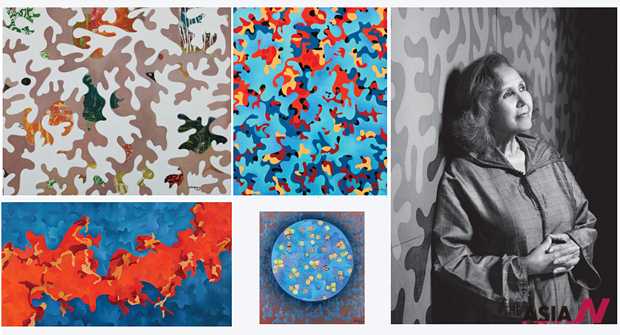Moroccan artist conveys her message through abstract works

Like a microscope which reveals more than it hides, the artist’s eyes reformulate life’s motifs. “Content” rather than “form” represents revolution now. That’s how artist Malika Aquznai’s works of art reflect content struggling for liberation in the context of revolt against stagnation.
*Editor’s note: This is the fourth installment of six-part stories about six Arab women artists devoting themselves to creating different style of art and innovating their methods of expression for “revolutionary” change.
Messages of peace, love, sympathy, modesty and generosity
Peace, love, sympathy, modesty, and generosity: Five words that make up the message of Moroccan artist Malika Aquznai, the angel of mercy who studied sociology and medicine before returning to the world of art to be reborn as an art lover, joining the School of Fine Arts in Casablanca where she graduated in1970. Over four decades she created a movement which drew heavily from heritage; in addition, she developed visual innovation either through engraving on zinc and bronze or painting in colour.
As I saw her at the arts workshop of the Asilah Cultural Forum in Morocco where she looked like a graceful, smiling butterfly I looked at her as an established artist, knowing nothing about the “arduous hilly journey” (in Palestinian poetess Fadwa Touqan’s words) which Malika had in order to be a professional artist.
In Morocco’s traditional society six decades ago it was difficult for young Malika’s artistic talent to be nurtured by a conservative family and society who look suspiciously at artists, let alone the girl who loved art and wanted to be an artist.
She entered the world of art formally after her marriage which allowed her to join the School of Fine Arts in Casablanca, a city on the threshold of change from a world heavily influenced by Eastern art to one which reformulated its origins and sources along Wesern lines, i.e. a world from the West, to the West, with Eastern tools and mood.
It is there that Malika joined those who adhered to their roots, not out of tradition, which is very easy, but to rediscover new worlds in heritage whose roots fascinate the audience’s literary and artistic imagination.
Abstraction, which, parallel to surrealism and post-surrealism, is very common in modern art, reducing form, symbolizing colour, with its geometrical borders, mental accuracy and repetitive language on the painting, is not alien to Morocco’s environment.
When you just walk into a Moroccan sultan’s palace and look at the engraved and coloured wooden ceilings or ceramic floors and walls you will see that abstract themes grow in Morocco as cedar trees do on the snowy heights of the Moroccan town of Ifran.
But we have to refer to another secret: Malika’s use of microscopes in hospital labs enabled her to see with her naked eye what we can’t, and to discover exceptional abstract worlds and paved the way for the rise of the rich world of algae in her works, a world inscribed with words the letters of which are her invention.
Malika has thus carried out her revolution in art, not just against convention or for innovation but against the use of computers which exist only in the world of abstraction. But Malika’s abstraction stems from the spirit to spread peace, love, sympathy, modesty and generosity. Algae and similar organisms cover Malika’s works, swimming in blue and green, as if they were the world of the ocean and sea along which Morocco’s shores stretch.
Let’s remember that the world of art in Morocco is much indebted to the activities of the Asilah Forum season, which has made Malika among other leading Moroccan artists one of its icons. In addition, the Forum has made art part of life and the public – artists, visitors and inhabitants – share in its world. It has also reactivated the educational role of those artists with colleagues from around the world, breeding new generations of art lovers whom we are in a pressing need for today. Asilah has always been a revolution in art, and so has Malika’s career been the full revolution of a versatile Arab artist.
Malika’s paintings are kept in museums in Morocco and abroad: Bandar bin Sultan Art Library in Asilah, the National Museum in Rabat, the World Bank in Washington, Baghdad Museum, Sharjah Museum and Akureyri Museum, Iceland. They are there carrying the message of peace, which we badly need today more than any time before.






























































